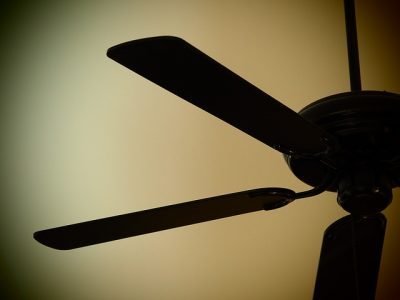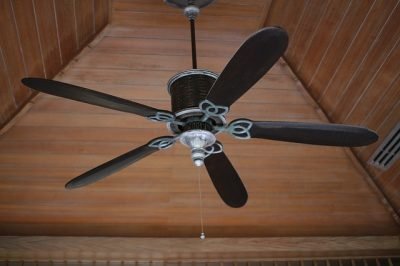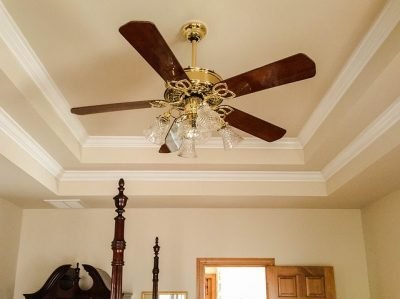As summer blazes on, so do our utility bills – having the air conditioner on full-blast is sometimes the only way for us to withstand the heat, without melting into a human puddle.
Or is it?

Ceiling fans might be a more traditional cooling device, but that’s not to say they aren’t effective – exemplifying the concept of the wind chill factor, the rotating blades of these fans create a sensation of decreased temperature due to air flow felt over skin. Picking the appropriate fan can not only help keep us that much cooler on warmer days, but also decreases our air conditioning’s workload – and keeps the costs down.
Thinking about getting a ceiling fan or two? Whether you’re looking for something plain and practical, or an option decked out with features like bright lights, here’s what you need to keep in mind.
Size
Ceiling fans are generally sorted by size, or in this case, diameter, and it’s important to pick one that complements and accommodates the size of the room it’s about to go in. Too big a room and the ceiling fan’s wind chill factor might be too negligible to make a difference, while too small a room, and the air flow might feel excessive and uncomfortable.
Manufacturers often include handy reference points to guide buyer decisions about the appropriate ceiling fans for various rooms. A standard estimation is that for small rooms around 75 square feet, such as a pantry, laundry room or bathroom, a 29 to 36 inch option is ideal. For rooms just above 100 square feet but below 150 square feet, a 36 to 42 inch fan is perfect, while for larger rooms, such as your kitchen or dining area or any other room clocking in closer to 175 square feet, a 42 to 48-inch option works best. 52 to 60 inch ceiling fans, on the other hand, are recommended for large, open-spaced rooms of or above 350 square feet, be it a wide living room, master bedroom or basement entertainment den.
Ceiling height

It is universally recommended to have your ceiling fan hanging at least 7 feet above the ground – meaning you need to take the height of your ceiling into consideration. For low-hanging ceilings, look out for flush-mount models, also known as ceiling huggers – these, as the names suggest, are attached close to the ceiling to leave adequate clearance underneath. For higher ceilings, you need to ensure that your chosen brand and model of ceiling fan can be installed with the distance between fan and ceiling adjusted using a downrod. Typically, standard ceiling fans come with a 6 to 8 inch adjustable downrod, but you’re going to need more length if your ceiling is above 8 feet high. Again, specific brands have their own length charts for buyers’ reference, though there are general estimations you can check up if you’re looking to get an idea first.
Intended Location
Are you planning on using the fan indoors, or outdoors, perhaps in a covered patio or a deck? Make sure you check your selected option bears the right UL rating. Dry rated fans are ideal for indoor use, whereas it’s imperative to pick a damp rated option for a covered outdoor area or a space prone to get humid, to ensure the device is safe to use and moisture-resistant without posing a risk of shorting and/or causing a fire. For spaces exposed to the elements, including rain and snow, a wet rated fan is essential.
Cubic Feet Per Minute
CFM, or cubic feet per minute, refers to the volume of air the ceiling fan can move every sixty seconds. Intuitively, the higher the CFM, the more the air flow and the greater the wind chill factor – though be aware that higher CFMs might also come packaged as noisier fans.
To offset the noise, look out for options with more powerful, bigger motors. Generally, the bigger the motor, the lower the noise – and the higher the price tag, although we think this is a valid example of value for money, since it’s still more cost-effective than footing the bills of air conditioners running around the clock. 188 to 212 millimeter motors offer both great air flow and little noise, with some 212 millimeter models verging on virtually noiseless. Fans with direct current (DC) motors, although the most expensive, are currently the most noiseless and efficient fans on the market – which leads us to our next point.
Energy Star Certification
The little blue label is a must if you’re looking to save electricity with your ceiling fan of choice – or if you’re looking to endorse an environmentally friendly brand doing the right things to reduce energy usage and demands. It might seem like a small consideration in the bigger picture, the most tangible effect the reduction by a couple of figures on your electricity bills, but in the long run you’ll be contributing to a nationwide movement of pursuing energy efficiency, so we can cultivate a practice of using what resources we have effectively while minimizing waste and toning down pollution. An Energy Star certified ceiling fan is up to 20% more efficient than other substitutes available on the market.
Blades
How many blades your ceiling fan has is as much a technical consideration as it is an aesthetic one. While four or five bladed fans might appear more pleasing to the eye, note that the greater the number of blades, the more the drag and therefore the less the air flow. On the up side, a higher number of blades decreases the amount of noise the fan makes, so it’s really a question of which trade-off you’re more willing to make.

Typically, three-bladed fans offer the most efficient air flow out of the models you have probably seen around, though there are two- and sometimes even one-bladed models out there. Some models with more than three blades have attachments specifically engineered to maximize airflow and keep noise down, but you’ll have to be discerning about their effectiveness and brand promise if you’re considering these options.
The angle of the blades – also referred to as the blade pitch – is of equal importance. Blades with a flatter pitch won’t require much force to spin through the air, but they will circulate less air than more angled blades. Angled or more steeply pitched blades, while requiring more force – in this case, a more powerful motor – to spin, offer better air flow. 14 degrees is considered a good angle for blade pitch, with a suitably powerful motor to back it up and keep it running effectively and efficiently.